Überclok Ion: Midrange Overclocking, with a Warranty
by Matt Campbell on February 12, 2008 4:10 AM EST- Posted in
- Systems
Overclocking (higher) and SLI
We've seen what the Ion can do as configured out of the box, but what about pushing it even farther? Where would upgrades be most effective? To answer these questions, we examined two possible paths to increasing performance: a faster processor and the addition of another 8800 GT for SLI.
Overclocking (higher)
Ok, so we voided the warranty - but with the Tuniq, airflow, and thermal protection, odds are extremely unlikely that a little experimentation will hurt. We opted to stay conservative, pushing the E4500 up another 300 MHz to 3.3GHz. Does this provide any gains at all?
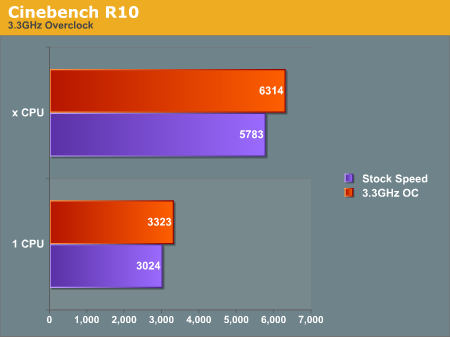
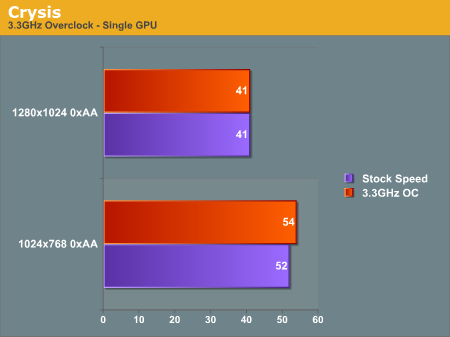
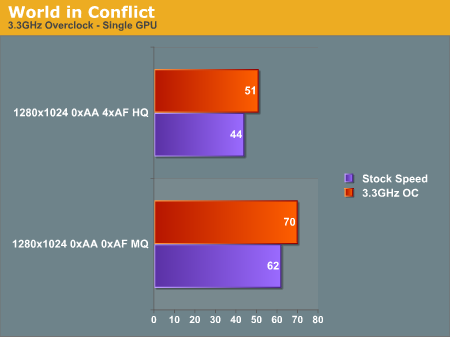
What do the above tell us? In our Cinebench CPU benchmark, a 10% increase in clock speed gives us about a 10% increase in score. With a control test established, we move on to gaming performance. At 1280x1024, we see large gains in performance in World in Conflict. Clearly, a faster CPU will aid greatly in this strategy game. In Crysis however, we see a clear hinge point, with a noticeable increase at 1024x768 and almost zero change at 1280x1024. As we found in our Shuttle review, the 8800 GT becomes completely GPU-bound at resolutions of 1280x1024 and higher.
8800 GT SLI
Now that we've looked at overclocking, what kind of a performance increase would we obtain if opted for another 8800 GT instead? We lowered the clocks of the Ion system back down to 3.0 GHz ("stock") and added another 8800 GT. The expandability of the system is really what facilitated this test; because the motherboard is SLI and the power supply is readily able to handle another video card (with an included PCIe power cable), installation was a 5-minute affair. What kind of numbers do we see now?
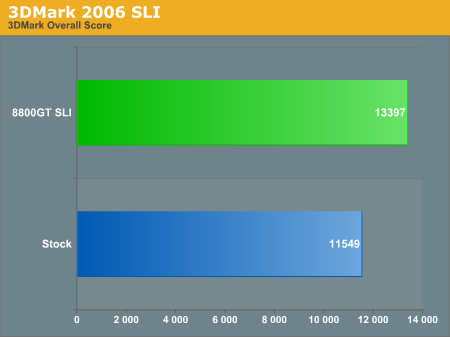
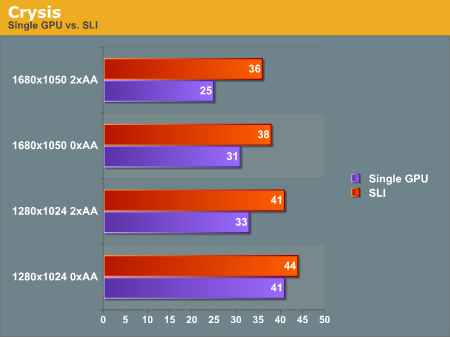
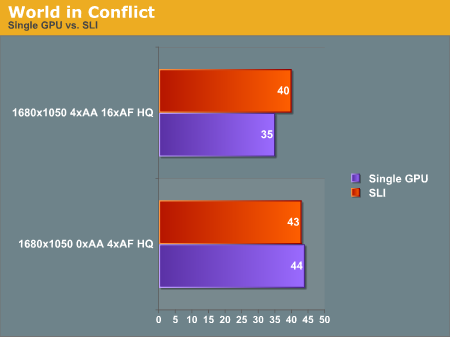
The synthetic benchmark shows a 16% performance gain at 1280x1024. Is this indicative of what we see in games? Not really - we have different constraints coming into play. World in Conflict is CPU hungry, as we showed in the overclocking section, and no increase at all is seen at up to 1680x1050 without antialiasing. Once we enable 4xAA, we do indeed see an increase, but it's still not tremendous. Crysis is a completely different story; while a CPU increase had little effect at 1280x1024 and above, the SLI configuration yields gains of up to 44%.
Which upgrade makes more sense? The above graphs are just a snapshot of performance, but depending on your monitor (i.e. the resolution you play games at) and the games you play, either upgrade could provide a reasonable performance boost. A CPU upgrade will help in many strategy games that tend to tax that area more, as well as Flight Simulator X; an E8400 at 4.0 GHz is an available upgrade on the Ion for $160, vs. a $290 upgrade for dual 8800 GTs, also making it an attractive choice cost-wise.
Crysis is somewhat unique in how much it relies upon a blazing fast graphics subsystem. If you intend to play Crysis at higher detail settings, then clearly you'll want to pony up for more GPU power as a CPU upgrade buys you nothing at higher resolutions. However, other games also demand a fast graphics subsystem, and more will likely come out in the near future. Obviously, if you want better performance in all situations, a faster CPU and a second GPU is the way to go, though at $400+ that's certainly not a cheap upgrade to make. One final thought is that you can always add a second GPU later and lose nothing; if you decide to upgrade CPUs down the road, you'll end up with a spare CPU. Thus, we'd recommend spending a bit more in the processor area if you can manage it.










38 Comments
View All Comments
Matt Campbell - Tuesday, February 12, 2008 - link
Snakeskin and zipties, plus all S-ATA drives except for the combo floppy/memory card reader, which uses a short rounded cable.JarredWalton - Wednesday, February 13, 2008 - link
FYI:The article has been updated with an enlarged image of the interior (on page 5). Click to get the large image.
chizow - Tuesday, February 12, 2008 - link
Glad to see a company using over the counter enthusiast parts for an enthusiast PC. This is a great option for those who want great performance now and future upgradability without the hassle and headache of a DIY/BYOPC. Here's to hoping they do well and last awhile!crimson117 - Tuesday, February 12, 2008 - link
I'd like to add my agreement that $400 is a great price point for a 3 year warranty, system assembly and software installation, and overclocking; and a little profit margin over their costs. You could pay close to $400 just for a warranty at other vendors, and you'd get a lot of junk installed, and it would be overclocked, and (with Dell for example) wouldn't even be overclockable or very expandable.If I were in the market for a new windows machine, I'd consider an Ion system :)
**Crimson117 Seal of Approval**
yyrkoon - Tuesday, February 12, 2008 - link
The 3 Year warranty is more like home owners insurance. They charge a flat rate to everyone, and do not 'pay-out' very often(no need if there is no problem). Of course the hardware components they've seem to have chosen all should have at least a 3 year OEM warranty, so for parts, they are not out a penny. I have not visited their website, or viewed the service policies, but I wonder how they handle part replacement in home. Dell will pay technicians such as ourselves here an hourly rate to replace parts that have gone bad in a customers PC, at their home. Well, to be more exact, a contractor will set everything up, and then contact us, etc.More likely that $400 is going to go towards customer support over the phone, or email etc.
This is actually not a bad idea, and if you choose your hardware carefully, document everything well in plain English(or whatever language), I suspect they could make a tidy profit, while keeping their customers close to 100% happy. Of course, how well they treat their customers remains to be seen.
7Enigma - Tuesday, February 12, 2008 - link
"Clearly, the 650W power supply still has a large amount of overhead. Estimating at 80% efficiency, at full load the Ion is still only using around 200W. This is good news for both stability and expansion."Uhh, 80% efficiency means it requires MORE power to supply the measured power draw. If you detected 248w at load, and the PS is 80% efficient, the Ion is using ~310w.
Great review btw, as I'm about to build my own system and its always nice to see a small new company like this come out. The first part of the review had me in a timewarp when Alienware had just came out. My dad purchased me a system for going to college from them when they were in their infancy. It came with a binder very similar to what Uberclock supplies and really made you feel like you were not getting another Dell/HP clone. I see good things for this company.....if they can get their name to come up with a search!
7Enigma - Tuesday, February 12, 2008 - link
Wanted to also mention that some of the graphs (especially the games) are confusing because its difficult to tell when you are comparing systems or just the same system at different resolutions/quality settings.ImSpartacus - Tuesday, February 12, 2008 - link
I agree, those graphs were messed up. I almost never get confused when reading an AT review.Lol, when in doubt skip to the conclusion to get a quick overview .)
JarredWalton - Tuesday, February 12, 2008 - link
Regarding power, PSUs are rated at what they can theoretically OUTPUT. Efficiency is a measure of how much power they draw from the wall vs. how much is actually passed on to components. The Kill-A-Watt devices are inexpensive tools to measure wall power draw, so if it draw 248W at load, 80% efficiency would mean that the PSU is only outputting 198W.While we do have someone that has all the necessary equipment for PSU testing, that equipment is in Europe and is prohibitively expensive. The rest of us make do with less sophisticated tools. On the other hand, knowing how much power a system really uses (at the outlet) is a useful metric, even if it wouldn't be as meaningful in a PSU review without knowing the power delivered.
7Enigma - Tuesday, February 12, 2008 - link
Ah, I now see what the author was getting at. The wording is a bit confusing though. It doesn't really matter how much the components are drawing, just how much power supply is drawing to power the components (I would omit the 200w figure).I think it might have been better worded as, "Clearly, even estimating 80% efficiency, the 650W power supply still has a large amount of overhead. This is good news for both stability and expansion."